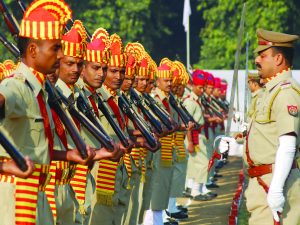 In addition, the Government has launched Interoperable Criminal Justice System (ICJS), which integrates the process of speedy justice by facilitating data-exchange between the courts, police, prosecution, jails and the forensic laboratories.
In addition, the Government has launched Interoperable Criminal Justice System (ICJS), which integrates the process of speedy justice by facilitating data-exchange between the courts, police, prosecution, jails and the forensic laboratories.
With a view to achieve the objectives of completion of police investigation within two months of filing FIR by police for sexual assaults, Government has facilitated monitoring of timelines in police investigation through the Investigation Tracking System for Sexual Offences (ITSSO) Portal, using CCTNS data. ITSSO is available to law enforcement agencies and gives details on pending cases.
The Government has also launched a National Database of Sexual Offenders (NDSO) for law enforcement officers. NDSO allows tracking of repeat and habitual sex offenders as well as initiate preventive measures against sexual offences. A cyber crime portal is also functional.
While ‘Police’ and ‘Public Order’ are State Subject as per schedule VII to the constitution of India, in order to supplement the efforts of the States for equipping and modernizing of their police forces, under the scheme of ‘Assistance to States for Modernization of Police’ {erstwhile scheme of Modernization of Police Force (MPF)}, the States have been provided central assistance for training gadgets, advanced communication, police buildings, police housing, mobility, and forensic equipment etc. as per the proposals of the State Governments in accordance with their strategic priorities and requirements.
“The Status of Policing in India Report 2019” prepared by Common Cause and Lokniti programme of the Centre for the Study of Developing Societies (CSDS) offers a policy-oriented insight into the conditions in which Indian police works. The analysis covers sensitivities and service conditions of police personnel, their resources and infrastructure, patterns of their routine contact with common people and the state of policing apparatus in the country.
Inadequate strength
The National Crime Records Bureau (NCRB) and the Bureau of Police Research and Development (BPRD) data shows that the police in India works at 77 per cent of its sanctioned strength, or just 3/4th of its required capacity. Vacancies in the senior ranks are higher than vacancies at the constabulary level ranks. This is despite the fact that only two States — West Bengal and Bihar have the ratio of constabulary to senior officers as per the Padmanabhaiah Committee recommendation, that is, four constabulary personnel per officer.
In all other States, the number of constables per officer is much higher. Over the last five years, on an average, only 6.4 per cent of the police force has been provided in-service training. Senior police officers are much more likely to receive in-service training than the constabulary-level personnel. Across the 22 States, 70 police stations do not have to wireless devices, 214 police stations do not have access to telephones, and 24 police stations have access to neither wireless nor telephones. On an average, the police stations in India have six computers per police station, but States like Assam and Bihar have an average of less than one computer per police station.
About 240 police stations across the 22 States have no access to vehicles. The representation of SCs, STs, OBCs and women in the police is poor, with huge vacancies in the reserved positions. There are 60 and 53 per cent vacancies for the reserved posts of SCs in UP and Haryana respectively, significantly higher than the overall vacancies in those States. The report suggests that SCs, STs, OBCs and women are less likely to be recruited/posted at officer-level ranks than general police personnel.
While transfer of SSPs and DIGs in less than two years has declined significantly since 2007, as of 2016, at the all India level 12 per cent officers of the ranks have been transferred in less than two years. The highest proportion of transfers in less than two years were made in Haryana and UP. Premature transfers are higher during election years in the States.
Long working hours
The report suggest that police personnel work for 14 hours a day on an average, with about 80 per cent police personnel working for more than 8 hours a day. Except Nagaland, the average working hours of personnel is between 11 to 18 hours in all of the selected 21 states. Nearly one in two personnel work overtime regularly, while eight out of ten personnel do not get paid for overtime work. Nearly three out of five respondents from the families of personnel were dissatisfied with the government provided housing quarters. One out of two personnel do not get any weekly off days. Three out of four personnel believe that their workload is affecting their physical and mental health.
One out of four personnel reported that senior police personnel ask their juniors to do their household/personal jobs even though they are not meant to do it. SC, ST and OBC personnel are more likely to report this than other caste groups. Two in five police personnel report the use of bad language by senior officers. Thirty-seven per cent personnel are willing to give up their jobs for another profession, if the perks and salaries remain the same.
Lack of resources
Twelve per cent personnel reported that there is no provision for drinking water in their police stations, 18 per cent said there are no clean toilets, and 14 per cent said there is no provision for seating area for the public. About forty-six per cent personnel have frequently experienced situations where they needed a government vehicle but it was not available. Further, 41 per cent personnel have frequently been in situations where they could not reach a crime scene on time because of lack of staff.
The extent of availability of digital and technological infrastructure is also poor. Eight per cent personnel said that functional computers are never available at their police stations, 17 per cent said that the CCTNS facility is never available and 42 per cent said that forensic technology is never available at the police station. Thirty-one per cent respondents from West Bengal and 28 per cent respondents from Assam said that a functional computer was never available at their police station/work place. This is despite the fact that as per official data released by NCRB, Assam scores high on level of compliance to CCTNS infrastructure. The report suggests that one in three civil police personnel never received training on forensic technology.
The new and emerging threats of cybercrimes, money laundering, terrorism and insurgency have posed new challenges to policing and intelligence gathering operations. Police forces the world over are experimenting with new levels of training and proficiencies, real-time use of data, humane but effective interrogation techniques and transparent tools of surveillance.
Cybercrimes like phishing, identity theft, online banking frauds are forcing the police to keep itself updated with the latest technology, and hence an urgent need to modernize and digitize policing. Campaigns like ‘Digital India’ would ring hollow, if the police are not equipped with computers and necessary software, along with the skilled and trained staff.
Working under pressure
Integration of women in police, aside from ensuring fair representation and diversity, is known to have positive impacts on the police structure. Studies have indicated that increasing female representation in the police is directly associated with increased reporting of violent crimes against women and decreased domestic violence his chapter focuses on the perceptions of personnel about the level of crime in their area or jurisdiction.
It further covers the experiences of personnel in the course of investigation and the hurdles faced by them, such as undue external pressure or interference from politicians, media, public, etc., as well as the common consequences of not complying with such pressures.
According to 36 per cent civil police personnel, crime has increased in the last two-three years While police personnel who think that crime has increased are most likely to attribute the phenomenon to societal reasons such as unemployment and lack of education, those who think that crime has decreased are most likely to offer improved policing (police becoming more active, stricter, etc.) as a primary reason for crime reduction.
Twenty-eight per cent police personnel believe that pressure from politicians is the biggest hindrance in crime investigation. One in three personnel have very frequently experienced political pressure in the course of crime investigation. Thirty-eight per cent personnel reported always facing pressure from politicians in cases of crime involving influential persons. Three out of five personnel reported transfer as the most common consequence of not complying with such external pressures.
Gender & Policing
In this chapter, policing is seen from the perspective of gender. On the one hand, we look at the experiences of women within the police force, as well as the perceptions of all personnel regarding women in the police. On the other hand, we look at the perceptions of personnel regarding complaints of crimes against women and gender-based violence. Women police personnel are more likely to be engaged in in-house tasks, such as maintaining registers, data, etc., while male personnel are more likely to be involved in field-based tasks, such as investigation, patrolling, law and order duties, etc.
One in five female personnel reported the absence of separate toilets for women at their police station/ workplace. One in four policewomen said there was no sexual harassment committee in their police station/jurisdiction. Over half of the personnel (both men and women) feel that men and women in the police force are not given completely equal treatment. Policewomen at higher ranks are more likely to report discrimination. States like Bihar, Karnataka and West Bengal have the highest levels of bias against women in the police force that is personnel from these States are most likely to believe that policewomen are less hardworking, less efficient, and should focus on their household duties.
Nearly one in five police personnel are of the opinion that gender-based violence complaints are false and motivated to a very great extent. Eight per cent personnel are of the opinion that transgender are very much naturally inclined towards committing crimes.
Sexual harassments
The Sexual Harassment of women at Workplace Act of 2013 makes it mandatory for all workplaces to constitute a committee, which will look into sexual harassment complaints faced by their female employees. Nearly one-fourth (24 per cent) of the police women surveyed reported the absence of such a committee in their workplace or jurisdiction. The position is dismal throughout the country. In 13 of the surveyed States, less than three-fourth of police-women reported the existence of such a committee.
Bihar’s situation was the worst, with 76 per cent of police-women reporting the absence of such a committee. Delhi, Andhra Pradesh, Rajasthan and Odisha are better placed, with 79 per cent or more police women from these States responding that the committee exists.
Cops willing to quit
Nearly two in every five police-women (37 per cent) said that they are willing to quit the police force and go for another job if the salary and perks remain the same, indicating a high level of dissatisfaction with their profession. With 63 per cent police-women willing to give up their job for an alternative one, which provides them with the same salary and perks, Uttar Pradesh leads the list. It is closely followed by Uttarakhand (54 per cent) and Himachal Pradesh (52 per cent). The dissatisfaction levels were also very high in Gujarat, Chhattisgarh and Kerala, with almost half of the police-women willing to switch their jobs.
Even the work profiles of women who are part of the existing police force reflect poor gender parity. Plugging the gaps in gender parity and equity will ensure better efficiency of the police. A gender-inclusive police force will certainly lead to greater trust build-up between the law-enforcement agency and the public, resulting in a smooth police-public interface. It would go a long way in making the police stations more accessible for women in general.
letters@tehelka.com













